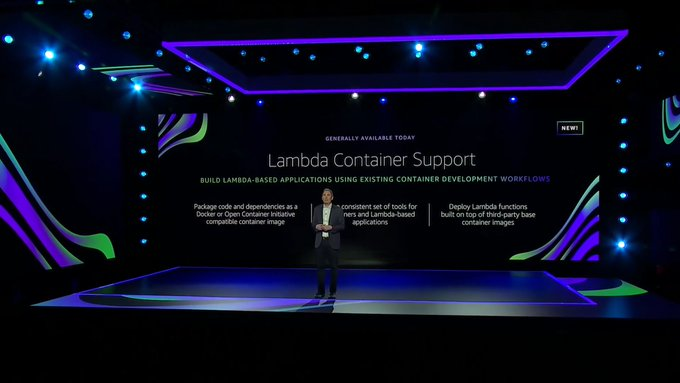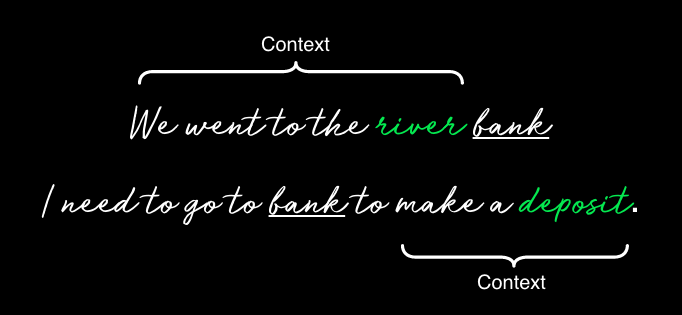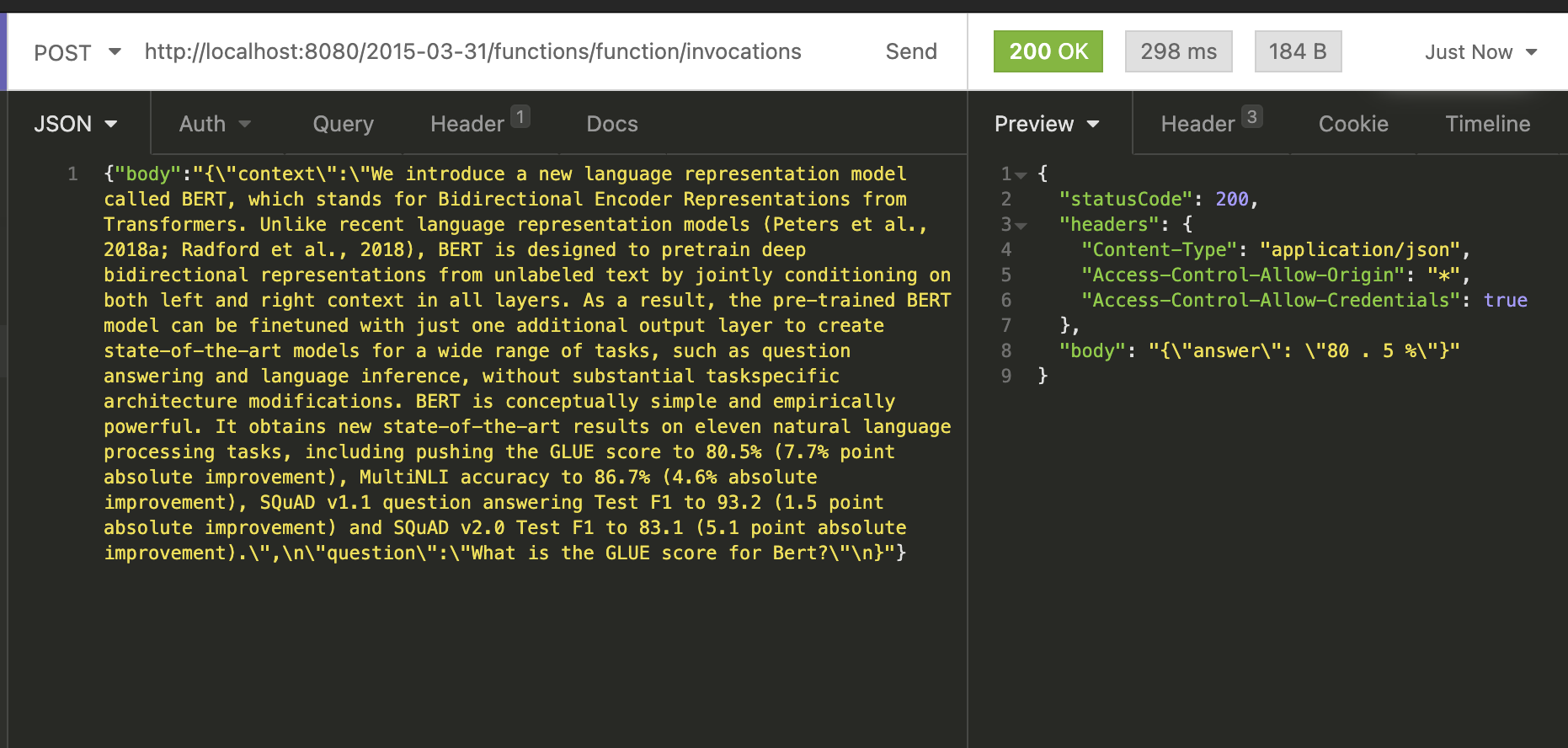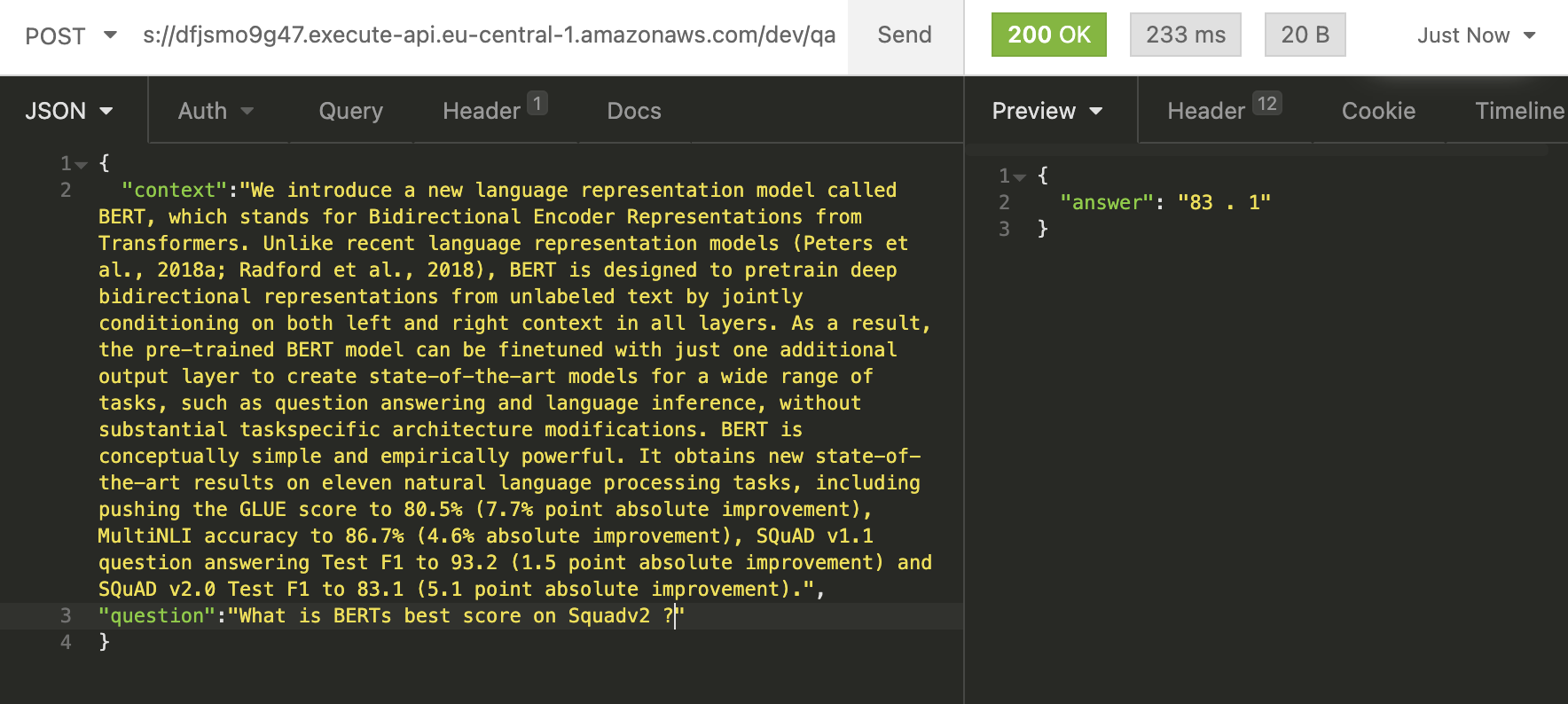Serverless BERT with HuggingFace, AWS Lambda, and Docker
It's the most wonderful time of the year. Of course, I'm not talking about Christmas but re:Invent. It is re:Invent time.

photo from the keynote by Andy Jassy, rights belong to Amazon
In the opening keynote, Andy Jassy presented the AWS Lambda Container Support, which allows us to use custom container (docker) images up to 10GB as a runtime for AWS Lambda. With that, we can build runtimes larger than the previous 250 MB limit, be it for "State-of-the-Art" NLP APIs with BERT or complex processing.
Furthermore, you can now configure AWS Lambda functions with up to 10 GB of Memory and 6 vCPUs.
For those who are not that familiar with BERT was published in 2018 by Google and stands for Bidirectional Encoder Representations from Transformers and is designed to learn word representations or embeddings from an unlabeled text by jointly conditioning on both left and right context. Transformers are since that the "State-of-the-Art" Architecture in NLP.

Google Search started using BERT end of 2019 in 1 out of 10 English searches, since then the usage of BERT in Google Search increased to almost 100% of English-based queries. But that's not it. Google powers now over 70 languages with BERT for Google Search.

https://youtu.be/ZL5x3ovujiM?t=484
We are going to use the newest cutting edge computing power of AWS with the benefits of serverless architectures to leverage Google's "State-of-the-Art" NLP Model.
We deploy a BERT Question-Answering API in a serverless AWS Lambda environment. Therefore we use the Transformers library by HuggingFace, the Serverless Framework, AWS Lambda, and Amazon ECR.
Before we start i wanted to encourage you to read my blog philschmid.de where i have already wrote several blog post about Serverless or How to fine-tune BERT models.
You find the complete code for it in this Github repository.
Transformers Library by Huggingface
The Transformers library provides state-of-the-art machine learning architectures like BERT, GPT-2, RoBERTa, XLM, DistilBert, XLNet, T5 for Natural Language Understanding (NLU) and Natural Language Generation (NLG). It also provides thousands of pre-trained models in 100+ different languages.
AWS Lambda
AWS Lambda is a serverless computing service that lets you run code without managing servers. It executes your code only when required and scales automatically, from a few requests per day to thousands per second.
Amazon Elastic Container Registry
Amazon Elastic Container Registry (ECR) is a fully managed container registry. It allows us to store, manage, share docker container images. You can share docker containers privately within your organization or publicly worldwide for anyone.
Serverless Framework
The Serverless Framework helps us develop and deploy AWS Lambda functions. It’s a CLI that offers structure, automation, and best practices right out of the box.
The Architecture

Tutorial
Before we get started, make sure you have the Serverless Framework configured and set up. You
also need a working docker environment. We use docker to create our own custom image including all needed Python
dependencies and our BERT model, which we then use in our AWS Lambda function. Furthermore, you need access to an AWS
Account to create an IAM User, an ECR Registry, an API Gateway, and the AWS Lambda function.
We design the API like that we send a context (small paragraph) and a question to it and respond with the answer to the question.
context = """We introduce a new language representation model called BERT, which stands for
Bidirectional Encoder Representations from Transformers. Unlike recent language
representation models (Peters et al., 2018a; Radford et al., 2018), BERT is
designed to pretrain deep bidirectional representations from unlabeled text by
jointly conditioning on both left and right context in all layers. As a result,
the pre-trained BERT model can be finetuned with just one additional output
layer to create state-of-the-art models for a wide range of tasks, such as
question answering and language inference, without substantial taskspecific
architecture modifications. BERT is conceptually simple and empirically
powerful. It obtains new state-of-the-art results on eleven natural language
processing tasks, including pushing the GLUE score to 80.5% (7.7% point absolute
improvement), MultiNLI accuracy to 86.7% (4.6% absolute improvement), SQuAD v1.1
question answering Test F1 to 93.2 (1.5 point absolute improvement) and SQuAD
v2.0 Test F1 to 83.1 (5.1 point absolute improvement)."""
question_one = "What is BERTs best score on Squadv2 ?"
# 83 . 1
question_two = "What does the 'B' in BERT stand for?"
# 'bidirectional encoder representations from transformers'What are we going to do:
- create a
PythonLambda function with the Serverless Framework. - add the
BERTmodel to our function and create an inference pipeline. - Create a custom
dockerimage - Test our function locally with LRIE
- Deploy a custom
dockerimage to ECR - Deploy AWS Lambda function with a custom
dockerimage - Test our Serverless
BERTAPI
You can find the complete code in this Github repository.
Create a Python Lambda function with the Serverless Framework.
First, we create our AWS Lambda function by using the Serverless CLI with the aws-python3 template.
serverless create --template aws-python3 --path serverless-bertThis CLI command will create a new directory containing a handler.py, .gitignore, and serverless.yaml file. The
handler.py contains some basic boilerplate code.
import json
def hello(event, context):
body = {
"message": "Go Serverless v1.0! Your function executed successfully!",
"input": event
}
response = {
"statusCode": 200,
"body": json.dumps(body)
}
return responseAdd the BERTmodel to our function and create an inference pipeline.
To add our BERT model to our function we have to load it from the
model hub of HuggingFace. For this, I have created a python script. Before we can
execute this script we have to install the transformers library to our local environment and create a model
directory in our serverless-bert/ directory.
mkdir model & pip3 install torch==1.5.0 transformers==3.4.0After we installed transformers we create get_model.py file in the function/ directory and include the script
below.
from transformers import AutoModelForQuestionAnswering, AutoTokenizer
def get_model(model):
"""Loads model from Hugginface model hub"""
try:
model = AutoModelForQuestionAnswering.from_pretrained(model,use_cdn=True)
model.save_pretrained('./model')
except Exception as e:
raise(e)
def get_tokenizer(tokenizer):
"""Loads tokenizer from Hugginface model hub"""
try:
tokenizer = AutoTokenizer.from_pretrained(tokenizer)
tokenizer.save_pretrained('./model')
except Exception as e:
raise(e)
get_model('mrm8488/mobilebert-uncased-finetuned-squadv2')
get_tokenizer('mrm8488/mobilebert-uncased-finetuned-squadv2')To execute the script we run python3 get_model.py in the serverless-bert/ directory.
python3 get_model.pyTip: add the model directory to gitignore.
The next step is to adjust our handler.py and include our serverless_pipeline(), which initializes our model and
tokenizer and returns a predict function, we can use in our handler.
import json
import torch
from transformers import AutoModelForQuestionAnswering, AutoTokenizer, AutoConfig
def encode(tokenizer, question, context):
"""encodes the question and context with a given tokenizer"""
encoded = tokenizer.encode_plus(question, context)
return encoded["input_ids"], encoded["attention_mask"]
def decode(tokenizer, token):
"""decodes the tokens to the answer with a given tokenizer"""
answer_tokens = tokenizer.convert_ids_to_tokens(
token, skip_special_tokens=True)
return tokenizer.convert_tokens_to_string(answer_tokens)
def serverless_pipeline(model_path='./model'):
"""Initializes the model and tokenzier and returns a predict function that ca be used as pipeline"""
tokenizer = AutoTokenizer.from_pretrained(model_path)
model = AutoModelForQuestionAnswering.from_pretrained(model_path)
def predict(question, context):
"""predicts the answer on an given question and context. Uses encode and decode method from above"""
input_ids, attention_mask = encode(tokenizer,question, context)
start_scores, end_scores = model(torch.tensor(
[input_ids]), attention_mask=torch.tensor([attention_mask]))
ans_tokens = input_ids[torch.argmax(
start_scores): torch.argmax(end_scores)+1]
answer = decode(tokenizer,ans_tokens)
return answer
return predict
# initializes the pipeline
question_answering_pipeline = serverless_pipeline()
def handler(event, context):
try:
# loads the incoming event into a dictonary
body = json.loads(event['body'])
# uses the pipeline to predict the answer
answer = question_answering_pipeline(question=body['question'], context=body['context'])
return {
"statusCode": 200,
"headers": {
'Content-Type': 'application/json',
'Access-Control-Allow-Origin': '*',
"Access-Control-Allow-Credentials": True
},
"body": json.dumps({'answer': answer})
}
except Exception as e:
print(repr(e))
return {
"statusCode": 500,
"headers": {
'Content-Type': 'application/json',
'Access-Control-Allow-Origin': '*',
"Access-Control-Allow-Credentials": True
},
"body": json.dumps({"error": repr(e)})
}Create a custom docker image
Before we can create our docker we need to create a requirements.txt file with all the dependencies we want to
install in our docker.
We are going to use a lighter Pytorch Version and the transformers library.
https://download.pytorch.org/whl/cpu/torch-1.5.0%2Bcpu-cp38-cp38-linux_x86_64.whl
transformers==3.4.0To containerize our Lambda Function, we create a dockerfile in the same directory and copy the following content.
FROM public.ecr.aws/lambda/python:3.8
# Copy function code and models into our /var/task
COPY ./ ${LAMBDA_TASK_ROOT}/
# install our dependencies
RUN python3 -m pip install -r requirements.txt --target ${LAMBDA_TASK_ROOT}
# Set the CMD to your handler (could also be done as a parameter override outside of the Dockerfile)
CMD [ "handler.handler" ]Additionally we can add a .dockerignore file to exclude files from your container image.
README.md
*.pyc
*.pyo
*.pyd
__pycache__
.pytest_cache
serverless.yaml
get_model.pyTo build our custom docker image we run.
docker build -t bert-lambda .Test our function locally
AWS also released the Lambda Runtime Interface Emulator that enables us to perform local testing of the container image and check that it will run when deployed to Lambda.
We can start our docker by running.
docker run -p 8080:8080 bert-lambdaAfterwards, in a separate terminal, we can then locally invoke the function using curl or a REST-Client.
curl --request POST \
--url http://localhost:8080/2015-03-31/functions/function/invocations \
--header 'Content-Type: application/json' \
--data '{"body":"{\"context\":\"We introduce a new language representation model called BERT, which stands for Bidirectional Encoder Representations from Transformers. Unlike recent language representation models (Peters et al., 2018a; Radford et al., 2018), BERT is designed to pretrain deep bidirectional representations from unlabeled text by jointly conditioning on both left and right context in all layers. As a result, the pre-trained BERT model can be finetuned with just one additional output layer to create state-of-the-art models for a wide range of tasks, such as question answering and language inference, without substantial taskspecific architecture modifications. BERT is conceptually simple and empirically powerful. It obtains new state-of-the-art results on eleven natural language processing tasks, including pushing the GLUE score to 80.5% (7.7% point absolute improvement), MultiNLI accuracy to 86.7% (4.6% absolute improvement), SQuAD v1.1 question answering Test F1 to 93.2 (1.5 point absolute improvement) and SQuAD v2.0 Test F1 to 83.1 (5.1 point absolute improvement).\",\n\"question\":\"What is the GLUE score for Bert?\"\n}"}'
# {"statusCode": 200, "headers": {"Content-Type": "application/json", "Access-Control-Allow-Origin": "*", "Access-Control-Allow-Credentials": true}, "body": "{\"answer\": \"80 . 5 %\"}"}%Beware we have to stringify our body since we passing it directly into the function (only for testing).

Deploy a custom docker image to ECR
Since we now have a local docker image we can deploy this to ECR. Therefore we need to create an ECR repository with
the name bert-lambda.
aws ecr create-repository --repository-name bert-lambda > /dev/nullTo be able to push our images we need to login to ECR. We are using the aws CLI v2.x. Therefore we need to define some
environment variables to make deploying easier.
aws_region=eu-central-1
aws_account_id=891511646143
aws ecr get-login-password \
--region $aws_region \
| docker login \
--username AWS \
--password-stdin $aws_account_id.dkr.ecr.$aws_region.amazonaws.comNext we need to tag / rename our previously created image to an ECR format. The format for this is
{AccountID}.dkr.ecr.{region}.amazonaws.com/{repository-name}
docker tag bert-lambda $aws_account_id.dkr.ecr.$aws_region.amazonaws.com/bert-lambdaTo check if it worked we can run docker images and should see an image with our tag as name

Finally, we push the image to ECR Registry.
docker push $aws_account_id.dkr.ecr.$aws_region.amazonaws.com/bert-lambdaDeploy AWS Lambda function with a custom docker image
I provide the complete serverless.yaml for this example, but we go through all the details we need for our docker
image and leave out all standard configurations. If you want to learn more about the serverless.yaml, I suggest you
check out
Scaling Machine Learning from ZERO to HERO. In
this article, I went through each configuration and explain the usage of them.
service: serverless-bert-lambda-docker
provider:
name: aws # provider
region: eu-central-1 # aws region
memorySize: 5120 # optional, in MB, default is 1024
timeout: 30 # optional, in seconds, default is 6
functions:
questionanswering:
image: 891511646143.dkr.ecr.eu-central-1.amazonaws.com/bert-lambda:latest #ecr url
events:
- http:
path: qa # http path
method: post # http methodTo use a docker image in our serverlss.yaml we have to image and in our function section. The image has the
URL to our docker image also value.
For an ECR image, the URL should look like this {AccountID}.dkr.ecr.{region}.amazonaws.com/{repository-name}@{digest}
In order to deploy the function, we run serverless deploy.
serverless deployAfter this process is done we should see something like this.

Test our Serverless BERT API
To test our Lambda function we can use Insomnia, Postman, or any other REST client. Just add a JSON with a context and
a question to the body of your request. Let´s try it with our example from the colab notebook.
{
"context": "We introduce a new language representation model called BERT, which stands for idirectional Encoder Representations from Transformers. Unlike recent language epresentation models (Peters et al., 2018a; Radford et al., 2018), BERT is designed to pretrain deep bidirectional representations from unlabeled text by jointly conditioning on both left and right context in all layers. As a result, the pre-trained BERT model can be finetuned with just one additional output layer to create state-of-the-art models for a wide range of tasks, such as question answering and language inference, without substantial taskspecific architecture modifications. BERT is conceptually simple and empirically powerful. It obtains new state-of-the-art results on eleven natural language processing tasks, including pushing the GLUE score to 80.5% (7.7% point absolute improvement), MultiNLI accuracy to 86.7% (4.6% absolute improvement), SQuAD v1.1 question answering Test F1 to 93.2 (1.5 point absolute improvement) and SQuAD v2.0 Test F1 to 83.1 (5.1 point absolute improvement).",
"question": "What is BERTs best score on Squadv2 ?"
}Our serverless_pipeline() answered our question correctly with 83.1.

The first request after we deployed our docker based Lambda function took 27,8s. The reason is that AWS apparently
saves the docker container somewhere on the first initial call to provide it suitably.
I waited extra more than 15 minutes and tested it again. The cold start now took 6,7s and a warm request around 220ms
Conclusion
The release of the AWS Lambda Container Support enables much wider use of AWS Lambda and Serverless. It fixes many existing problems and gives us greater scope for the deployment of serverless applications.
We were able to deploy a "State-of-the-Art" NLP model without the need to manage any server. It will automatically scale up to thousands of parallel requests without any worries. The increase of configurable Memory and vCPUs boosts this cold start even more.
The future looks more than golden for AWS Lambda and Serverless.
You can find the GitHub repository with the complete code here.
Thanks for reading. If you have any questions, feel free to contact me or comment on this article. You can also connect with me on Twitter or LinkedIn.